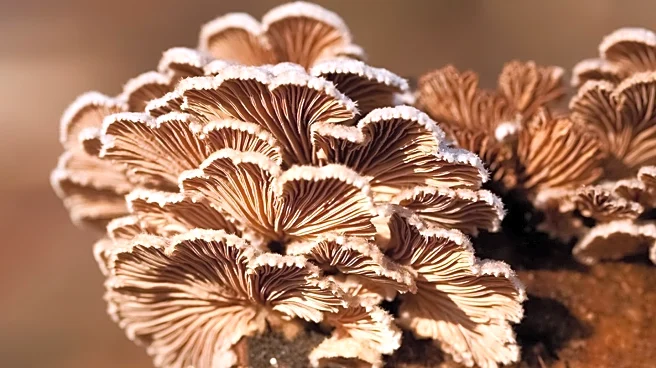What is the story about?
What's Happening?
A rare fungus known as the Candelabra Coral has been recorded in Leicestershire for the first time. The discovery was made by the Leicestershire Fungi Study Group in Burrow Wood, near Copt Oak, on September 28. Melinda Bell, a retired biology teacher, spotted the fungus on a moss-covered log during a walk. Previously thought extinct in the UK, the Candelabra Coral was last recorded in Suffolk in 2012, marking its reappearance after 116 years. The fungus is recognized by its crown-like tips resembling castle turrets and feeds on dead and rotting wood. Geoffrey Hall from the study group noted that the fungus is part of a large group of fungi that decompose and recycle woody material, playing a vital role in maintaining healthy forests.
Why It's Important?
The discovery of the Candelabra Coral in Leicestershire highlights the importance of fungi in woodland ecosystems. These organisms are crucial for decomposing and recycling organic material, which helps maintain forest health. The presence of such rare fungi can indicate the ecological richness and biodiversity of an area. This finding may encourage further study and conservation efforts to protect and understand the role of fungi in local ecosystems. Additionally, the reappearance of a fungus thought extinct underscores the dynamic nature of ecosystems and the potential for rediscovery of other rare species.
What's Next?
The Leicestershire Fungi Study Group may continue to monitor the area for further sightings of the Candelabra Coral and other rare fungi. This could lead to increased interest in fungal studies and conservation efforts in the region. Researchers might investigate the factors contributing to the fungus's sudden appearance and its ecological impact. Local conservation groups could use this discovery to advocate for the protection of woodland areas, ensuring the preservation of biodiversity and ecosystem health.
Beyond the Headlines
The rediscovery of the Candelabra Coral raises questions about the factors influencing the presence and visibility of rare species. It may prompt discussions on the impact of climate change, habitat loss, and human activity on fungal populations. Understanding these dynamics could lead to broader ecological insights and inform conservation strategies. The study of fungi, often overlooked, is essential for grasping the complexities of ecosystem interactions and the role of microorganisms in environmental health.
AI Generated Content
Do you find this article useful?













